1 1
Page 24
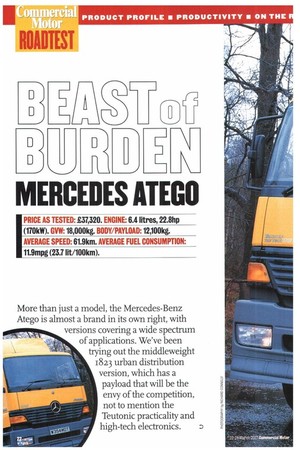
Page 26
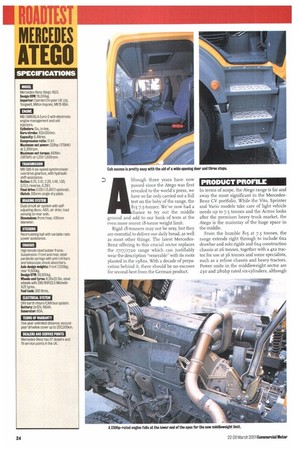
Page 27
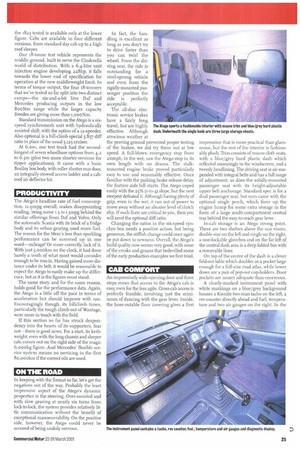
Page 28
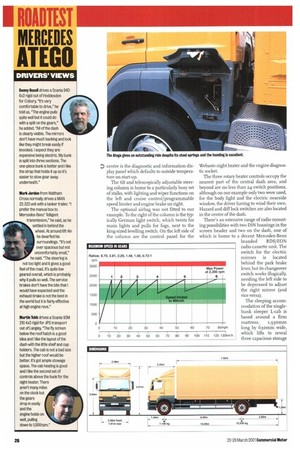
Page 29
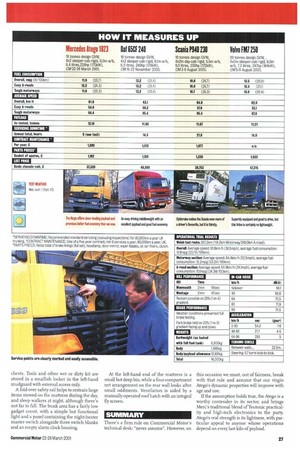
If you've noticed an error in this article please click here to report it so we can fix it.
MERCEDES ATEGO
IPRICE AS TESTED: 237,320. ENGINE: 6.4 litres, 22.8hp (170kW). GM: is,000kg. BODY/PAYLOAD: wookg. AVERAGE SPEED: 61.9km. AVERAGE FUEL CONSUMPTION: 11.9mpg (23.71a/100km).
More than just a model, the Mercedes-Benz Atego is almost a brand in its own right, with versions covering a wide spectrum of applications. We've been trying out the middleweight 1823 urban distribution version, which has a payload that vvill be the envy of the competition, not to mention the Teutonic practicality and high-tech. electronics.
D lthough three years have now
Ach passed since the Atego was first revealed to the world's press, we have so far only carried out a full test on the baby of the range, the 815 7.5-tonner. We've now had a
ance to try out the middle ground and add to our bank of tests at the even more recent t8-tonne weight limit.
Rigid 18-tonners may not be sexy, but they are essential to deliver our daily bread, as well as most other things. The latest MercedesBenz offering to this crucial sector replaces the 1717/1720 range which can justifiably wear the description -venerable" with its roots planted in the 19805. With a decade of preparation behind it, there should be no excuses for second-best from the German product.
PRODUCT PROFILE
In terms of scope, the Atego range is far and away the most significant in the MercedesBenz CV portfolio. While the Vito, Sprinter and Vario models take care of light vehicle needs up to 7.5 tonnes and the Actros looks after the premium heavy truck market, the Atego is the mainstay of the huge space in the middle.
From the humble 815 at 7.5 tonnes, the range extends right through to include 6x2 drawbar and solo rigids and 6x4 construction chassis at 26 tonnes, together with a 4x2 tractor for use at 36 tonnes and some specialists, such as a refuse chassis and heavy tractors. Power units in the middleweight sector are 230 and 280hp rated six-cylinders, although the 1823 tested is available only at the lower figure. Cabs are available in four different versions, from standard day cab up to a high roof sleeper.
Our r8 -tonne test vehicle represents the middle ground, built to serve the Cinderella world of distribution. With a 6.4-litre unit injection engine developing 228hp, it falls towards the lower end of specification for operation at the new middleweight limit. In terms of torque output, the four 18-tonners that we've tested so far split into two distinct camps—the six-and-a-bit litre Daf and Mercedes producing outputs in the low 8 ooNm range while the larger capacity Swedes are giving more than t,000 Nm.
Standard transmission on the Atego is a sixspeed synchromesh unit with hydraulically assisted shift, with the option of a 12-speeder. Also optional is a hill-climb special 5.857 diff ratio in place of the usual 5.125 cruiser.
At 6.om, our test truck had the secondlongest of seven wheelbase options from 4.2 to 6.3m (plus two more shorter versions for tipper applications). • It came with a basic Boalloy box body, with roller shutter rear door, an integrally-stowed access ladder and a cabroof air deflector kit.
PRODUCTIVITY
The Atego's headline rate of fuel consumption, 11.9mpg overall, makes disappointing reading, being some 1.3 to i.5mpg behind the similar offerings from Daf and Volvo. Only the automatic Scania with its brick of a fridge body and its urban gearing used more fuel. The reason for the Merc's less than sparkling performance can be summed up in one word—mileage! Or more correctly, lack of it. With just 5, 000km on the clock, it had done barely a tenth of what most would consider enough to be run-in. Having gained more distance under its belt, it would be reasonable to expect the Atego to easily make up the difference, but as it is the figures must stand.
The same story, and for the same reason, holds good for the performance data. Again, the Atego is a little off the pace in terms of acceleration but should improve with use. Encouragingly though, its hillclimb times, particularly the tough climb out of Wantage, were more in touch with the field.
If this section so far has struck despondency into the hearts of its supporters, fear not—there is good news. For a start, its kerbweight, even with the long chassis and sleeper cab, comes out on the right side of the magic 6,000kg figure. And Mercedes' flexible service system means no servicing in the first 8o,000km if the correct oils are used.
ON THE ROAD
In keeping with the format so far, let's get the negatives out of the way. Probably the least impressive aspect of the Atego's dynamic properties is the steering. Over-assisted and with slow gearing at nearly six turns from lock-to-lock, the system provides relatively little communication without the benefit of exceptional manoeuvrability. On the positive side, however, the Atego could never be accused of being unduly nervous. In fact, the handling is excellent as long as you don't try to drive faster than you can twirl the wheel. From the driving seat, the ride is outstanding for a steel-sprung vehicle and even from the rigidly-mounted passenger position the ride is perfectly acceptable.
The all-disc electronic service brakes have a fairly long travel, but are highly effective. Although atrocious weather at the proving ground prevented proper testing of the brakes, we did try them out at low speed. A full-blown emergency stop from 2omph, in the wet, saw the Atego stop in its own length with no drama. The stalkmounted engine brake proved particularly easy to use and reasonably effective. Once familiar with the parking brake release delay, the feature aids hill starts. The Atego coped easily with the 25% (I-in-4) slope, but the next steepest defeated it. Although having plenty of grip, even in the wet, it ran out of power to move away without an abusive level of clutch slip. If such feats are critical to you, then you will need the optional diff ratio.
Changing the ratios in the six-speed synchro box needs a positive action, but being generous, the stiffish change could once again be put down to newness. Overall, the Atego's build quality now seems very good, with none of the creaks and groans that bedevilled some of the early production examples we first tried.
CAB COMFORT
An impressively wide-opening door and three steps mean that access to the Atego's cab is easy, even for the less agile. Cross-cab access is perfectly feasible, involving just the minimum of dancing with the gear lever. Inside, the hose-outable floor covering gives a first impression that is more practical than glamorous, but the rest of the interior is fashionably plush. Trim consists of mauve cloth seats, with a blue/grey hard plastic dash which reflected annoyingly in the windscreen, and a tweedy headlining. The driving seat is air-suspended with integral belts and has a full range of adjustment, as does the solidly-mounted passenger seat with its height-adjustable upper belt anchorage. Standard spec is for a dual passenger seat, but ours came with the optional single perch, which frees up the engine hump for some extra storage in the form of a large multi-compartment central tray behind the easy-to-reach gear lever.
In-cab storage is an Atego strong point. There are two shelves above the sun visors, double size on the left and single on the right, a non-lockable glovebox and on the far left of the central dash area is a deep lidded bin with a removable liner.
On top of the centre of the dash is a clever fold-out table which doubles as a pocket large enough for a full-size road atlas, while lower down are a pair of pop-out cup-holders. Door pockets are nearer adequate than enormous.
A clearly-marked instrument panel with white markings on a blue/grey background houses a Kienzle two-man tacho on the left, a rev-counter directly ahead and filet temperature and two air gauges on the right. In the
centre is the diagnostic and information display panel which defaults to outside temperature on start-up.
The tilt and telescopically adjustable steering column is home to a particularly busy set of stalks, with lighting and wiper functions on the left and cruise control/programmable speed limiter and engine brake on right.
The optional airbag was not fitted to our example. To the right of the column is the typically German light switch, which twists for main lights and pulls for fogs, next to the king-sized levelling switch. On the left side of the column are the control panel for the Webasto night heater and the engine diagnostic socket.
The three rotary heater controls occupy the nearest part of the central dash area, and beyond are no less than 24 switch positions, although on our example only two were used, for the body light and the electric nearside window, the driver having to wind their own. Hazard and diff lock switches are also located in the centre of the dash.
There's an extensive range of radio mounting possibilities with two DIN housings in the screen header and two on the dash, one of which is home to a decent Mercedes-Benz branded RDS/EON radio cassette unit. The switch for the electric mirrors is located behind the park brake lever, but its changeover switch works illogically, needing the left side to be depressed to adjust the right mirror (and vice versa).
Max Power at 2,300 rpm 6
The sleeping accommodation of the singlebunk sleeper L-cab is based around a firm mattress, i.omm long by 630mm wide, which lifts to reveal three capacious storage chests. Tools and other wet or dirty kit are stored in a smallish locker in the left-hand mudguard with external access only.
A fold-over safety rail helps to restrain large items stowed on the mattress during the day, and sleep walkers at night, although there's not far to fall. The bunk area has a fairly low gadget count, with a simple but functional light and a panel containing the night-heater master switch alongside three switch blanks and an empty alarm clock housing.
At the left-hand end of the mattress is a small but deep bin, while a four-compartment net arrangement on the rear wall looks after small oddments. Ventilation is aided by a manually-operated roof hatch with an integral fly screen.
SUMMARY
There's a firm rule on Commercial Motor's technical desk: "never assume". However, on this occasion we must, out of fairness, break with that rule and assume that our virgin Atego's dynamic properties will improve with age and use.
If the assumption holds true, the Atego is a worthy contender in its sector, and brings Merc's traditional blend of Teutonic practicality and high-tech electronics to the party. Atego's real strength is its lightness, with particular appeal to anyone whose operations depend on every last kilo of payload.
































































































